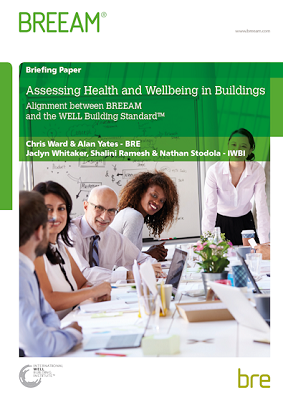Assessing health and wellbeing in buildings
In January 2018, BRE and the International WELL Building Institute pbc (IWBI™) released a new, improved briefing paper that outlines how projects may achieve both a certified BREEAM rating and WELL Certification post-occupation.
Following the 2016 announcement of an agreement between the two organisations to pursue alignments between WELL and BREEAM; the crosswalk document, Assessing Health and Wellbeing in Buildings, was first published in early-2017 to make it easier for those wishing to obtain both a certified BREEAM rating and a WELL Certified™ rating.
The document provides guidance on how the process for pursuing dual certification may be streamlined, and offers information for architects and designers to better understand the requirements and how the two standards relate. It also sets out the areas where WELL requirements are addressed by UK and/or EU regulations, and where these can be omitted from an assessment for buildings undergoing a WELL assessment in these territories.
Specific improvements and enhancements to the guidance document include instructions for projects that clarify how to use the crosswalk, minor amendments to the alignments and overlaps between the two standards, and a simplified labeling system. The new crosswalk also features useful notes and comments to clarify these alignments.
BREEAM and WELL are both evidence-based systems that have best practice, continual improvement and the interest of both the environment and people at their heart. Certification under both systems is pursued through the submission of project documentation and on-site post-occupancy performance testing.
The publication of the briefing paper comes at a time when corporations as well as the real estate industry are increasingly looking at how the built environment impacts human health as well as sustainability.
Alan Yates, BREEAM Technical Director, said: “The document will allow clients and design teams to use the same evidence in both schemes. When you need or want both certification schemes, this document will guide project teams on the most efficient way of going through the process. They won’t need to duplicate evidence or calculate things in different ways, as approximately 35 % of credits are equivalent or aligned in some way. This will ultimately reduce the burden of assessing both schemes.”
This article was originally published here on 1 Feb 2017 by BRE Buzz. It was written by Simon Guy.
--BRE Buzz
[edit] Related articles on Designing Buildings Wiki
- Are we doing the right thing? Shaping well-being into the future of our urban communities.
- BRE Buzz articles on Designing Buildings Wiki.
- BREEAM.
- BREEAM Assessor.
- Building Back Better: Health.
- Building for wellbeing.
- Building up wellbeing in construction.
- Human comfort in buildings.
- Measuring the wellbeing benefits of interior materials.
- Performance in use.
- Phobias.
- The Flourish Model to enhance wellbeing.
- WELL and BREEAM align.
- WELL Building Standard.
- Wellbeing and buildings.
- Wellbeing considerations for property managers.
Featured articles and news
Amendment to the GB Energy Bill welcomed by ECA
Move prevents nationally-owned energy company from investing in solar panels produced by modern slavery.
Gregor Harvie argues that AI is state-sanctioned theft of IP.
Heat pumps, vehicle chargers and heating appliances must be sold with smart functionality.
Experimental AI housing target help for councils
Experimental AI could help councils meet housing targets by digitising records.
New-style degrees set for reformed ARB accreditation
Following the ARB Tomorrow's Architects competency outcomes for Architects.
BSRIA Occupant Wellbeing survey BOW
Occupant satisfaction and wellbeing tool inc. physical environment, indoor facilities, functionality and accessibility.
Preserving, waterproofing and decorating buildings.
Many resources for visitors aswell as new features for members.
Using technology to empower communities
The Community data platform; capturing the DNA of a place and fostering participation, for better design.
Heat pump and wind turbine sound calculations for PDRs
MCS publish updated sound calculation standards for permitted development installations.
Homes England creates largest housing-led site in the North
Successful, 34 hectare land acquisition with the residential allocation now completed.
Scottish apprenticeship training proposals
General support although better accountability and transparency is sought.
The history of building regulations
A story of belated action in response to crisis.
Moisture, fire safety and emerging trends in living walls
How wet is your wall?
Current policy explained and newly published consultation by the UK and Welsh Governments.
British architecture 1919–39. Book review.
Conservation of listed prefabs in Moseley.
Energy industry calls for urgent reform.


























